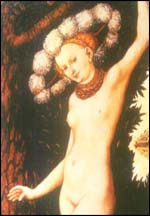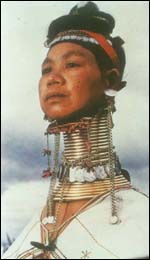| |
Cosmetic Surgery
What is Beauty ?
This is a very philosophical question. For many of us there is an answer that cannot be put into words but we recognize that something is beautiful when we see it. This feeling is based on the harmony of form, color and mood that is created by the particular object. The most fundamental concepts of beauty in the human face have changed dramatically over the centuries but some things are constant. If there is one single method for defining beauty, it relies on a particular balance of characteristics. All men are familiar with the particular proportions between bust size, waist, and hips known as the fundamental measurements of a woman's figure. These measurements in some sense give us a standard to work from and a common language to use. This concept has changed since the ages. In India, the 600AD sculptures on temple walls defined beautiful body proportions as big busts and big buttocks. (Fig A). But during the Renaissance, in Europe, paintings on canvasses revealed a preference for small busts and small buttocks (Fig B). The medium of expression used then by the artists was stone and canvas respectively. Today it is the TV, film or print media.
 |
 |
fig(A) |
fig(B) |
Likewise in the face, the distances between the eyes, the nose, and the mouth have preferred proportions although these are not so easily quantified. Leonardo da Vinci recognized that the properly proportioned face is usually divided into equal thirds of the forehead, midface, and chin regions. Beyond these physical measurements, our minds add other unique preferences. Some of these are based on cultural differences. To any men or women, their mother or father had some features that they idealize. By society and the media, we have been conditioned towards a platonic ideal. This idea is that there is a perfect apple to which all other apples are compared. Likewise, there is the perfect face or body style by which all other bodies are measured. The selection of this ideal is in no way absolute and changes from time to time.
 |
fig(C) |
For instance, in recent times the Indian society might select Aishwarya Rai, a Miss Universe, or the American culture might select screen star Marilyn Monroe as an ideal (herself a plastic surgery addict). .Each model or image that is considered beautiful, like Marilyn's, is often burned into the minds of the followers through repetition usually in the form of marketing, advertisement, album covers, magazines, and bill boards. Thus, the template becomes ingrained and is readily recalled. The human mind, when comparing another face to this Marilyn ideal, will subconsciously generate a model of Marilyn Monroe. Then it will average the features from the face in front of it and see how close they match. Marilyn then functions as a norm and the observer then identifies the areas of similarity and the particular failures to match that template. If the areas of matching are close enough, the observer will consider the subject beautiful based on this premise, that Marilyn is beautiful. If too many areas do not match up, the subject will be rejected. For instance one mole might be considered a cute facial characteristic but a face full of moles would be problematic. Given that background it becomes more apparent why the idea of beauty tends of regress towards a mean. There is a tendency for everyone to try to look alike. Even within the large collection of appearances that might be included or characterized as beautiful, there are certain deviations that are too far from the norm to be considered acceptable in most cases. Anything from an exaggerated distance between the eyes, a large hump on the nose, particularly small or large lips might be unacceptably distant from the platonic ideal. Small deviations from the standards go unnoticed in society or many be considered cute, unique characteristics. Large deviations are readily recognized, detract from the natural harmony of the face, and may be distracting. Gross deviations from the model of normal are considered deformities and may turn the subject into a psychological outcast. If people are asked to compare random pictures and decide which face is the most beautiful, they will select the one in which they can not find any fault. For the most part, a large nose or small chin that is exaggerated beyond our concepts of "average", will rarely be considered beautiful. Human beings are incredibly unique because of their facial features. We are virtually the only species of animal that can recognize such a large variety of individual members based on their physical appearance, in particular their facial appearance. Then there are a myriad of expressions that can be generated from each of those basic facial structures. Facial expression provide a powerful tool of non-verbal communication that truly qualifies it in a classical sense of its own. Although some of us have a personality that tends to thrive on a unique appearance, in many cases others may feel that it draws undesirable attention to ourselves. For some people, their appearance may detract from the verbal or emotional message they are trying to convey. It doesn't represent their inner nature accurately. While people deliberately make the choice to dismiss what should be considered an evolutionary advantage of enhanced individuality, there appears to be a point at which assimilation into society breeds a level of comfort and control over one's appearance. Often this may stem from admiration of the success of a friend or a well-known personality. To some extent the individual that needs this sort of support has a need for social acceptance and this is very normal. In conclusion, it is hard to decide where the conflict between what is beauty and what is simply conformity. The doctor can help decide that physical changes people need and also if these changes will meet their other expectations.
|
|